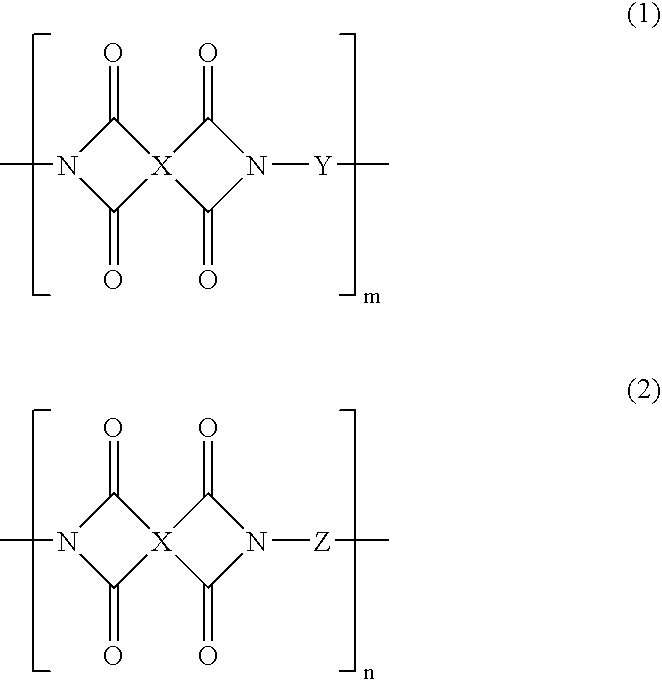Phenolic hydroxyl-bearing polyimide resin, making method and polyimide resin composition
a technology of phenolic hydroxyl and polyimide resin, which is applied in the field of polyimide resins, can solve the problems of insufficient adhesion of resin to copper foil, less heat resistance, and inability to achieve the adhesion effect of hydroxyl radicals arising from the reaction of phenolic hydroxyl radicals with epoxy resin, and achieves the effect of imparting flexibility and not being able to exp
- Summary
- Abstract
- Description
- Claims
- Application Information
AI Technical Summary
Benefits of technology
Problems solved by technology
Method used
Image
Examples
synthesis example 1
[0064] A 1-liter separable flask equipped with a 25-ml water metering receiver coupled to a reflux condenser through a cock, a thermometer and a stirrer was charged with 44.03 parts of a linear dimethylpolysiloxane blocked with a .gamma.-aminopropyldimethylsiloxy radical at each end of the molecular chain, KF-8010 (Shin-Etsu Chemical Co., Ltd.) and 100 parts of cyclohexanone as a reaction solvent. By stirring at 80.degree. C., the diamine was dispersed. A solution of 38.72 parts of 6FDA (2,2-bis(3,4-dicarboxyphenyl)hexafluoropropane) as an acid anhydride in 100 parts of cyclohexanone was added dropwise to the dispersion. The solution was stirred for 8 hours at 80.degree. C. for reaction, thereby synthesizing an acid anhydride-rich amic acid oligomer.
[0065] Next, a 1-liter separable flask equipped with a 25-ml water metering receiver coupled to a reflux condenser through a cock, a thermometer and a stirrer was charged with 17.25 parts of a phenolic hydroxyl radical-containing aromati...
synthesis example 2
[0067] A 1-liter separable flask equipped with a 25-ml water metering receiver coupled to a reflux condenser through a cock, a thermometer and a stirrer was charged with 44.03 parts of a linear dimethylpolysiloxane blocked with a .gamma.-aminopropyldimethylsiloxy radical at each end of the molecular chain, KF-8010 (Shin-Etsu Chemical Co., Ltd.) and 100 parts of cyclohexanone as a reaction solvent. By stirring at 80.degree. C., the diamine was dispersed. A solution of 38.72 parts of 6FDA (2,2-bis(3,4-dicarboxyphenyl)hexafluoropropane) as an acid anhydride in 100 parts of cyclohexanone was added dropwise to the dispersion. The solution was stirred for 8 hours at 80.degree. C. for reaction, thereby synthesizing an acid anhydride-rich amic acid oligomer.
[0068] Then 25 ml of toluene was admitted into the flask, after which the temperature was elevated to about 160.degree. C., at which reflux continued for 2 hours. It was confirmed that a predetermined amount of water collected in the wat...
synthesis example 3
[0071] A 1-liter separable flask equipped with a 25-ml water metering receiver coupled to a reflux condenser through a cock, a thermometer and a stirrer was charged with 17.25 parts of the phenolic hydroxyl radical-containing aromatic diamine (Diamine 1) shown above, 44.03 parts of a linear dimethylpolysiloxane blocked with a .gamma.-aminopropyldimeth-ylsiloxy radical at each end of the molecular chain, KF-8010 (Shin-Etsu Chemical Co., Ltd.) and 200 parts of cyclohexanone as a reaction solvent. By stirring at 80.degree. C., the diamines were dispersed. A solution of 38.72 parts of 6FDA (2,2-bis(3,4-dicarboxyphenyl)hexafluoropropane) as an acid anhydride in 100 parts of cyclohexanone was added dropwise to the dispersion. The solution was stirred for 8 hours at 80.degree. C. for reaction whereupon a gel formed. Toluene, 25 ml, was then admitted, after which the temperature was elevated to about 160.degree. C., at which reflux continued for 2 hours. It was confirmed that a predetermine...
PUM
| Property | Measurement | Unit |
|---|---|---|
| Equivalent mass | aaaaa | aaaaa |
| Temperature | aaaaa | aaaaa |
| Fraction | aaaaa | aaaaa |
Abstract
Description
Claims
Application Information
 Login to View More
Login to View More - Generate Ideas
- Intellectual Property
- Life Sciences
- Materials
- Tech Scout
- Unparalleled Data Quality
- Higher Quality Content
- 60% Fewer Hallucinations
Browse by: Latest US Patents, China's latest patents, Technical Efficacy Thesaurus, Application Domain, Technology Topic, Popular Technical Reports.
© 2025 PatSnap. All rights reserved.Legal|Privacy policy|Modern Slavery Act Transparency Statement|Sitemap|About US| Contact US: help@patsnap.com



